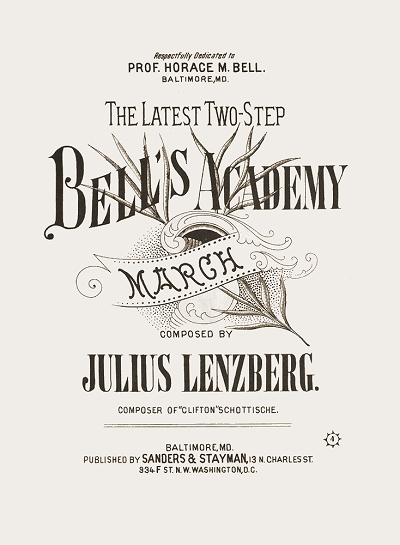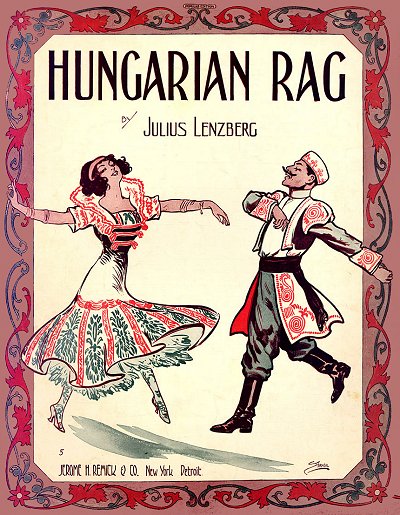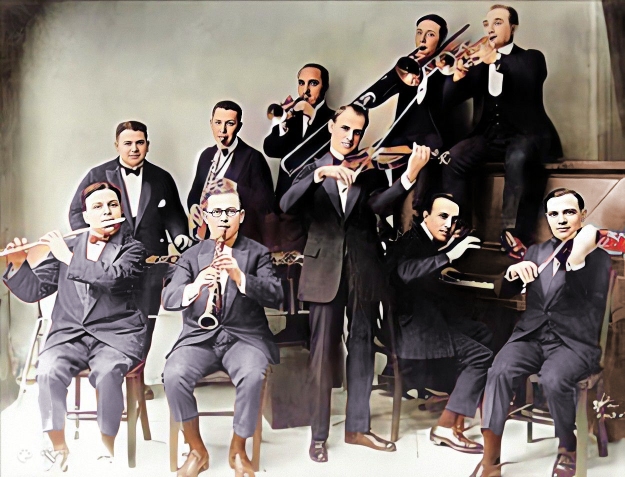
Julius Lenzberg (January 3, 1878 to April 24, 1956) | |
 Compositions Compositions | |
|
1894
Clifton -SchottischeBell's Academy March 1898
Gallant Commodore1899
Bon Nuit (Good Night): March1902
The Reindeer: Grand Galop de Concert1904
My Own Plantation Home Among the PinesI'll Be Happy When I'm Thinking of You [w/C.E. Smith] 1907
A Jewel SetLittle Diamond: Schottische Little Pearl: Waltz Little Ruby: March Little Emerald: Polka Little Onyx: Gavotte Little Sapphire: Reverie 1911
Haunting RagThat Madrid Rag |
1913
Hungarian RagMarch of the Nations Some Baby 1914
Operatic RagThe D.V. (Duryea Valse) [as Oscar Duryea] Colonial Rag [w/Ernest R. Ball] 1915
Merry WhirlCup Hunters 1916
Valse Inspiration1917
Rag-a-MinorThe Ritz Duryea Waltz 1919
Razzle Dazzle: One-StepMoonlight on the Nile: Solo Moonlight on the Nile [w/Gus Kahn & Bud G. DeSylva] 1923
American Ideal: March |
 Selected Discography Selected Discography | |
|
1919
Moonlight on the Nile [3]Razzle Dazzle [3] Tiger Rose Waltzes [3] Pretty Little Rainbow [3] 1920
Buddah [3]Karavan [3] Venetian Moon [3] Rose of Washington Square [3] A Young Man's Fancy [3] Manyana [3] Dance-O-Mania [3] Amorita [3] Feather Your Nest [3] Speed [3] Grieving for You/Medley [3] Cuban Moon [3] 1921
I Like It [3]Come and Nestle in Your Daddy's Arms [3] Ilo (A Voice from Mummyland) [1] Cherie [1] Vamping Rose [1] Emaline [1] You Made Me Forget How to Cry [1] Stolen Kisses [1] Ma (He's Makin' Eyes at Me) [1] Tea Cup Girl [2] Who'll Be the Next One? [2] Sweetheart [1] Oh Me! Oh My!/Dolly [1] All By Myself [3] Ain't We Got Fun [3] Ma (He's Makin' Eyes at Me) [3] Second Hand Rose [1] Violet [1] Gypsy Blues [1] Salomay [1] Dapper Dan [3] Yoo Hoo [3] South Sea Isle [3] Ten Little Fingers and Ten Little Toes [3] I've Got My Habits On [3] Wabash Blues [3] Kill 'em With Kindness [1] 1922
I Want Love [1]Say It with Kisses [2] Stealing [2] Bluebird, Where Are You? [2] Boo Hoo Hoo [4] Virginia Blues [4] Sing Song Man [3] Honey Lou [3]
1. Julius Lenzberg and His Orchestra
2. Jules Lenzbergs Harmonists 3. Lenzberg's Riverside Orchestra 4. Lenzberg Midnight Frolic Orchestra |
Matrix and Date
[Edison 6908] ??/1919[Edison 3792] ??/1919 [Edison 3799] ??/1919 [Edison 3954] 11/21/1919 [Edison 3983] ??/1920 [Edison 4014] ??/1920 [Edison 4027] ??/1920 [Edison 4095] ??/1920 [Edison 4106] ??/1920 [Edison 4115] ??/1920 [Edison 4137] ??/1920 [Edison 4166] 09/10/1920 [Edison 4190] 10/1920 [Edison 4223] 10/1920 [Edison 7607] 10/1920 [Edison 7791] 02/10/1921 [Bell 034] 02/1921 [Bell 064] 03/1921 [Bell 064] 03/1921 [Bell 071] 05/1921 [Bell 071] 05/1921 [Bell 076] 05/1921 [Bell 084] 05/1921 [Bell 085] 05/1921 [Bell 084] 05/1921 [Okeh 4337] 05/1921 [Okeh 4338] 05/1921 [Paramount 768] 07/1921 [Paramount 769] 07/1921 [Banner 797] 07/1921 [Bell 089] 08/1921 [Bell 078] 08/1921 [Okeh 4461] 10/1921 [Okeh 4473] 10/1921 [Grey Gull 525] 10/1921 [Grey Gull 526] 10/1921 [Grey Gull 527] 10/1921 [Banner 933] 11/1921 [Banner 934] 11/1921 [Banner 935] 11/1921 [Okeh 4503] 12/1921 [Okeh 4529] 01/1922 [Okeh 4530] 01/1922 [Okeh 4554] 01/1922 [Banner 990] 02/1922 [Banner 991] 02/1922 [Banner 1021] 05/1922 [Banner 1022] 05/1922 |
Julius Lenzberg was born in Baltimore, Maryland to German (Prussian) immigrants Henry Lenzberg and Julia Stern. He was the youngest child of a large family,  including Benjamin (10/1860), Sophia (1861), Maurice (10/1864), Emma (1866), Ella (1868), Alfred (1869 - died young), Hattie (1871), and Florence (9/1875). Henry was employed as a cigar packer in Baltimore since at least a decade before Julius was born.
including Benjamin (10/1860), Sophia (1861), Maurice (10/1864), Emma (1866), Ella (1868), Alfred (1869 - died young), Hattie (1871), and Florence (9/1875). Henry was employed as a cigar packer in Baltimore since at least a decade before Julius was born.
 including Benjamin (10/1860), Sophia (1861), Maurice (10/1864), Emma (1866), Ella (1868), Alfred (1869 - died young), Hattie (1871), and Florence (9/1875). Henry was employed as a cigar packer in Baltimore since at least a decade before Julius was born.
including Benjamin (10/1860), Sophia (1861), Maurice (10/1864), Emma (1866), Ella (1868), Alfred (1869 - died young), Hattie (1871), and Florence (9/1875). Henry was employed as a cigar packer in Baltimore since at least a decade before Julius was born.One of a considerable pool of talented composers from Baltimore, Julius was classically grounded with an ear for melody. He soon became competent in music theory, and performance on both piano and violin. Jules, as he often referred to himself, likely played either piano or violin for a Baltimore dance school known as Bell's Academy, and composed a march for it dedicated to the director and founder, Professor Horace M. Bell. He worked for a while at the Weber and Fields Vaudeville Club in Baltimore, but when it closed in November, 1897, 19-year-old Lenzberg started advertising that he was "at liberty," noting his services as a leader on violin and piano, and as an arranger in the New York Clipper and some other trade papers. While it listed his Baltimore address, it noted that he had been "last season's leader" at Smith's Theater in Bridgeport, Connecticut.
In 1900, having already locally published two marches, he was listed in the census as a musician in Baltimore, although still living with his parents and some of his older siblings. His newly formed "orchestra of soloists" performed in New York in October, 1900, at the Al Reeve's Music Hall. In January of 1904, Jules married his German-born wife Ella Thomas in Manhattan, and the couple settled permanently in New York City so he could pursue musical leadership.
Jules quickly found work leading an ensemble at the Circle Theater in New York, and started on the first of many summers playing on Long Island and Long Branch. As noted in the New York Times social column at the beginning of the 1903 and 1904 seasons, he provided music for the summer at the Scarboro Hotel. Lenzberg soon became the musical director of the Colonial Theater in New York, and is mentioned in the New York Times on July 1, 1906, as managing the orchestra of the Long Beach Hotel on Hempstead Bay, Long Island, for the summer season. He was working mostly as a musician at that time, and if there were any compositions coming from his pen, they were not being published for those few years.
By 1910 Julius and Ella made their home in Queens, New York, with Julius listed as a traveling musician in the census. This was also the beginning of his most productive period as a composer,  submitting many clever rags that reflected his classical background and taste for whimsy and stage presentation. While not huge sellers, with the exception of Hungarian Rag, they provided a comfortable supplemental income for the couple. But it was his musical leadership that was his strongest asset, as noted in this December, 1913 mention in The New York Clipper: "The have an orchestra at the Colonial that, for its size, would be hard to equal, much less excel. Julius Lenzberg, himself an artistic performer, always has his musicians under perfect control, and the resulting unified effort, supplemented by training and efficiency of a high order was fittingly shown in two selections."
submitting many clever rags that reflected his classical background and taste for whimsy and stage presentation. While not huge sellers, with the exception of Hungarian Rag, they provided a comfortable supplemental income for the couple. But it was his musical leadership that was his strongest asset, as noted in this December, 1913 mention in The New York Clipper: "The have an orchestra at the Colonial that, for its size, would be hard to equal, much less excel. Julius Lenzberg, himself an artistic performer, always has his musicians under perfect control, and the resulting unified effort, supplemented by training and efficiency of a high order was fittingly shown in two selections."
 submitting many clever rags that reflected his classical background and taste for whimsy and stage presentation. While not huge sellers, with the exception of Hungarian Rag, they provided a comfortable supplemental income for the couple. But it was his musical leadership that was his strongest asset, as noted in this December, 1913 mention in The New York Clipper: "The have an orchestra at the Colonial that, for its size, would be hard to equal, much less excel. Julius Lenzberg, himself an artistic performer, always has his musicians under perfect control, and the resulting unified effort, supplemented by training and efficiency of a high order was fittingly shown in two selections."
submitting many clever rags that reflected his classical background and taste for whimsy and stage presentation. While not huge sellers, with the exception of Hungarian Rag, they provided a comfortable supplemental income for the couple. But it was his musical leadership that was his strongest asset, as noted in this December, 1913 mention in The New York Clipper: "The have an orchestra at the Colonial that, for its size, would be hard to equal, much less excel. Julius Lenzberg, himself an artistic performer, always has his musicians under perfect control, and the resulting unified effort, supplemented by training and efficiency of a high order was fittingly shown in two selections."Lenzberg's hits during the ragtime era were few but noteworthy. One of his great talents was adapting well-known classical tunes to piano ragtime format. Among these are his Hungarian Rag and Operatic Rag. They helped fuel a trend in which rag composers such as George L. Cobb and Felix Arndt, as well as various performers, ragged famous tunes, often to the detriment of both the original and arranging composers. Mr. Lenzberg's arrangements are actually fresh and innovative in their use of these themes, unlike many similar yet lesser attempts. His Haunting Rag is among the most original of his works. Lenzberg also co-composed a rag with the esteemed ballad writer Ernest R. Ball.
The Lenzbergs spent the rest of their lives in Queens. Like his famous associate, composer George Botsford, Lenzberg had a group called the Harmonists that performed in vaudeville theaters, and were found listed several times throughout the 1910s on various bills. On his 1918 draft record he listed his occupation as orchestra leader. Lenzberg was the musical director for one of earliest renditions of the famous George White Scandals, working for the George White Scandals of 1919. It ran for 128 performances from June through October, interrupted for two weeks by an Actor's Equity strike.
By late 1918, Julius was working as a manager with the Keith Theater Company, one of the few remaining vaudeville chains, at the B.F. Keith New Riverside Theater. He recorded a good number of dance tunes with that organization's Riverside Orchestra starting in 1919, largely for the Edison Blue Amberol cylinders and Diamond Discs, and reportedly some for the Pathé label. A notice in the Music Trade News of December 25, 1920, describes a special moment he had with that group: "Julius Lenzberg, leader of the orchestra at the Riverside Theatre, New York, recently featured during the intermission 'Tired of Me,' the new Irving Berlin, Inc., number. Mr. Lenzberg is something of a violin soloist himself, and put over the number so well that he was compelled to play the chorus twice. 'It is the first time I ever heard an audience demand an encore during intermission,' declared Mr. Lenzberg."
Henry Lenzberg had died by 1920, and Jules' mother and his sister Florence moved in with him. He and his wife evidently never had children. The Riverside Orchestra remained popular for some time, as evidenced in this New York Evening Telegram notice of October 16, 1922:
 |
Julius Lenzberg. the popular orchestra leader at B.F. Keith's Riverside, is soon to don make-up and go right out on the platform Just like a regular actor. The week of October 23 Julius and his Riverside Theatre Orchestra have been booked Into the bill at the Riverside as a special added attraction and will go upon the stage for a routine of popular dance numbers, besides playing the rest of the show from, the pit.
They will have a special setting, and Julius is busy working out original arrangements and effects. Lenzberg has composed several popular successes, among which Is "Rag-A-Minor." and with his orchestra has made many records for some of the best known phonograph companies in America.
An expert violinist and a conductor of more than usual personality, he has gained the sobriquet of "The Sousa of Theatre Orchestra."
Jules recorded several more sides in 1921 and 1922 with his Julius Lenzberg's Harmonists on the Okeh label, various New York labels such as Paramount/Banner, Bell/Arto with Julius Lenzberg and His Orchestra, and on Banner/Triangle with his Jules Lenzberg's Midnight Follies group. Although the recordings stopped in 1922, he continued appearances throughout the decade, occasionally on radio. One of the stars of his 1924 Hippodrome orchestra was the mando-cello player, Alfred Allen, who brought notoriety to the unusual instrument. He was involved with the Hippodrome through most of the mid to late 1920s, according to notices seen in the New York Times. Other articles confirm the existence of a Julius Lenzberg Symphony Orchestra as well in the mid to late 1920s, but no specifics on what they played. For some time during the decade he also led the pit orchestra at the storied Palace Theater, the pinacle of vaudeville houses. A popular conductor and arranger there, they called him "The Professor." In the 1930 census Lenzberg was still listed as an orchestra leader.
Again he hit Broadway and also some of the more legitimate concert halls. Lenzberg was the musical director for the 1931 stage musical Nikki, which ran a difficult 39 performances from September through October. Among the future stars of this near flop were Fay Wray in the title role of Nikki, and Archie Leach as romantic interest Cary Lockwood. Leach would eventually take the first name of his character and make a splash in the movies as Cary Grant. The Great Depression was not kind to Broadway except for the Gershwin brothers. So in 1932 he became involved with symphonic music again as the assistant director of the Roxy Theater Symphony Orchestra run by the well-known impresario Hugo Riesenfeld. The organization also was featured on occasional radio concerts, even traveling to Chicago for appearances on WGN. He may have done some seasonal work out of New York as well, as he owned a home in Forest Hills.
Jules eventually moved into management, away from the grind of preparing musical presentations on a weekly basis. In the 1940 enumeration he and Ella were still living Queens, New York, and he listed himself as a musician. His employer listed on his 1942 draft record was Select Operating Corporation, a theatrical management and property broker that included the Shubert Organization. They are still in business today, and located in the Times Square theater district in Manhattan. Mostly retired, he returned to the pit of the Palace Theater on August 10, 1948, for a star-studded gala that was broadcast live on ABC television station WJZ (although probably to just a few hundred homes). The 1950 census taken in Hempstead, Long Island, New York, confirmed his status as retired. Information on Lenzberg from that time until his death has proven difficult to find. Julius Lenzberg, a long-time music veteran and creative force, passed on at age 78 in 1956.